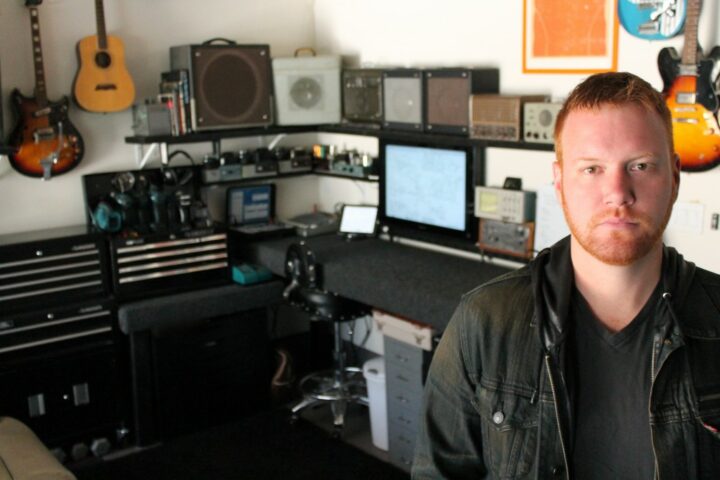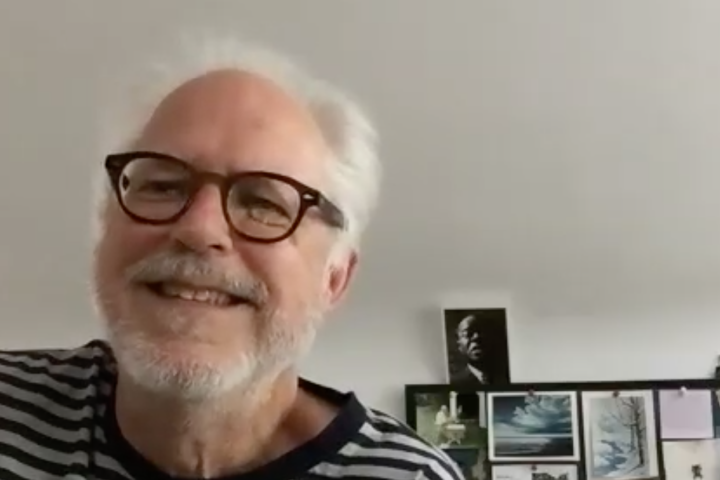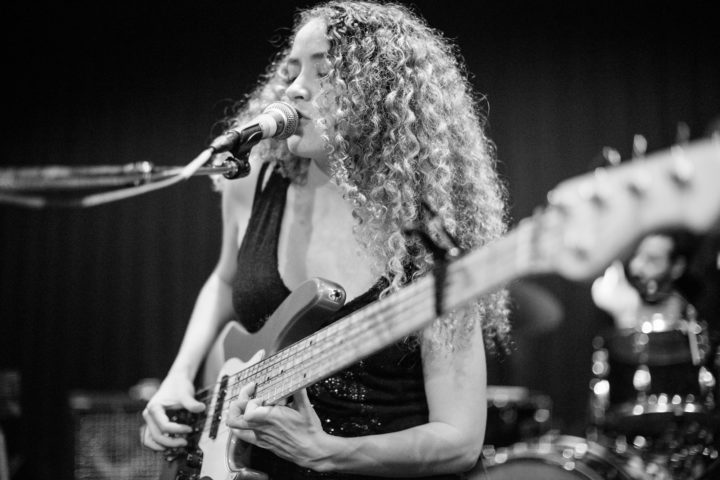This is the second part of a conversation we had with Anthony Wilson. If you haven’t yet, check out Part I: Making Frogtown, in which we cover a bit of what went into making the record – the composition process, recording, influences et cetera. Here, in Part II: Guitar Talk, we get into the guitar geekery, talking gear, technique and, of course, nail care.
Fretboard Journal: We ought to talk about gear, I know you mentioned the flattop was a J-45…
Anthony Wilson: Yeah, it was a 1955 J-45, in beautiful condition. I used that as the basis track for a lot of things – definitely “She Won’t Look Back,” “Frogtown,” I think “Our Affair,” definitely “Arcadia,” “I Saw It Through the Skylight” and “Downtown Abbey.” “Shabby Bird” was a different Gibson flattop; it was a little different, it had a more “charming” sound rather than a “thumpy” sound. When I picked up that J-45 I just liked the way it felt in my hands so much, and I liked the bass response to it, and the things I was playing, some of it was fingerpicking things, I just liked the the thump of it, but for “Shabby Bird” it wasn’t right. The one we used on “Shabby Bird” was a smaller-bodied guitar, not an L-00, maybe an LG… it had almost a kalimba sound to it, it was just right, and Matt Chamberlain was playing this part just blended with that guitar.
So that was the basic, and then later on we’d go back and I’d add electric guitar.
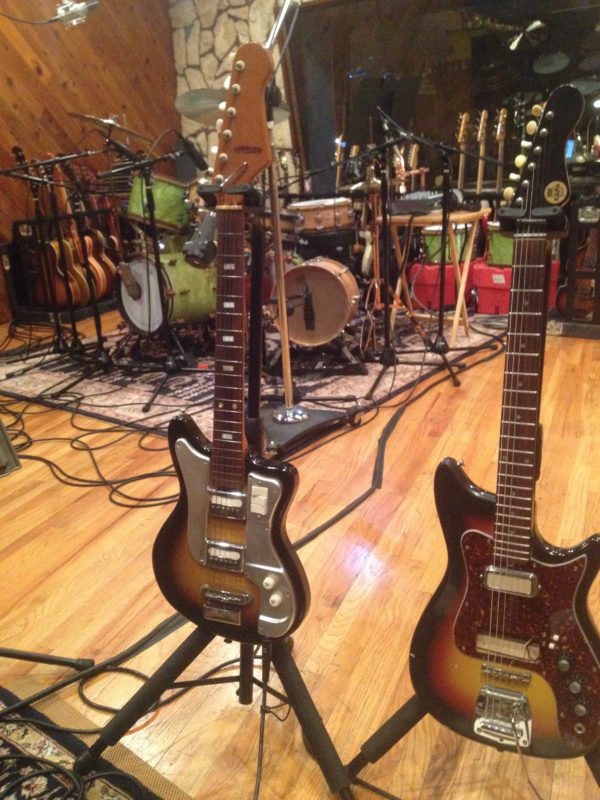
Anthony used a number of guitars on this record, none of which were his Monteleone archtop. The electrics he played included the Custom Craft and Kapa (at right), his ‘69 Les Paul Deluxe and two guitars he discovered at the studio that belong to producer/bassist Mike Elizondo: a Kay arch top (see Part I) and a 1959 Telecaster. Anthony favors strings from the Gabriel Tenorio String Company and has been talking to Gabriel about a special set of brass-wounds for his Monteleone archtop.
Mike has an insane amount of amps in the room, and as we started getting into it, he pulled out amps, and, what he clued in to early on was, if we spent too much time looking for amp tones we could also lose a bit of the immediacy of performance. We did it a couple of times and we always ended up going back to the film amp – I have one of Austen Hooks’s film [projector] amps, and a cabinet that has a P15N Jensen from the ‘60s, and a spring reverb, that’s what we went to, and I got one of Austen’s “space heater” amps, too…
FJ: Space heater amps?
AW: Oh, he calls it a “space heater” but it’s a film [projector]… there’s that classic Bell & Howell 398A, and then there’s another version, another film projector that was also made by Bell & Howell, for the military, and they’re these funny looking things – they look like a little space heater. They have a small speaker, a little 4″ or 5″ speaker… for something like what Blake [Mills] does, he really uses all these speakers for different stuff. For me, I tend to use the space heater for an overdriven sound – it’s super low wattage and super creamy-crunchy without using any pedals at all; it’s just beautiful, saturated overdrive at lower volumes. Maybe I used my Princeton, which is a ‘65, on one song, with the Tele, for that “compact” sound, but we found it was easier, more true to the process of making the album to just use the amp that I use, just for the immediacy of getting the performance. And they’re just the nicest amps, so responsive and so beautiful, and the way they break up at lower volumes is gorgeous, and I love the 15″ speaker – for me, that’s my favorite thing about everything; it’s this old 15″ speaker that’s so warm and so, kinda “bloomy” and… I love it.
There’s something that happens, overall, with the sound with that 15″ speaker that I hadn’t experienced before that I found really intriguing. It really lent itself to the way I play. It felt a little less punchy – I have a Pro Reverb with two old Jensen 12″s; it’s a great, great-sounding amp. But I find that if I’ve been playing the 15″ a lot and I go to that, the two 12s are a little too much in my face, they’re too crunchy, whereas that 15″ doesn’t feel crunchy in that way, it feels kinda creamy. If I’m playing something like my archtop, my Monteleone, it warms up that instrument in a beautiful way, not that it isn’t warm already, it just does something even more… it rounds things out, it relaxes things.
It’s nice to have that to go to. I know that sometimes Wes [Montgomery] really liked to use 15s, and I know that… well, Ted Greene, he was interested in the specifics of any kind of speaker, but I know he really did like 15s, he loved that sound.
FJ: What about your guitar setup? Strings, and so on…
AW: All this stuff is so funny to me because, I mean, I’m funny… I’m funny to me. I don’t put a lot of thought into a lot of these things until maybe something that’s happening physically with the setup that I’m using starts to frustrate me. And usually I can’t quite tell what’s happening. For a long time I played with heavier strings and then something started to feel weird. I thought, “Could it be that the strings are too heavy and the guitar is a little choked? Now let me make a little change and see what happens, and see if it feels good to me.” But I definitely know other players who really think a lot about these things. If I go to visit John Pisano, or when I used to go [visit] Ted [Greene]… Ted was different because he thought a lot about stuff but he still just sorta instinctively did things. But if I go visit John Pisano, he’ll say, “Man I put these strings on this one, and I put these strings on that guitar…” He’s always experimenting with all that stuff. He’s genuinely really curious about how these things affect the guitars that he plays. He’ll say, “Well, it worked fine on my 175 and I tried it on my Epiphone and I couldn’t stand it. I had to go back to the other…” He’ll play with all this stuff, little, slight variations in setup. I guess I’ve never been that guy. I always wonder what’s wrong with me, that I don’t think about this stuff that much. I guess we’re all different. Some people have dedicated little shops where they practice to really tweak setups and tweak angles and little things like that. I guess we all have different approaches, it’s so interesting to me.
FJ: You fingerpick a lot on Frogtown. Do you use just use your fingers?
AW: Fingers. Sometimes a flatpick and three fingers, or sometimes all fingers. I started off using a flatpick and then expanded and kind of created whatever, for me, is my own technique of flatpick and fingers. But it had become something that I wanted to explore over the last few years, to play more with only fingers, so I try to do that even if it’s against what my instinct would be, sometimes – to just leave that flatpick on the table. I find that it forces me into slightly different ways of playing when I have the index finger available to play with, when it’s four fingers and the thumb. I kinda conceive of the bass strings differently when I do that, and the other strings as well… the way I voice things changes.
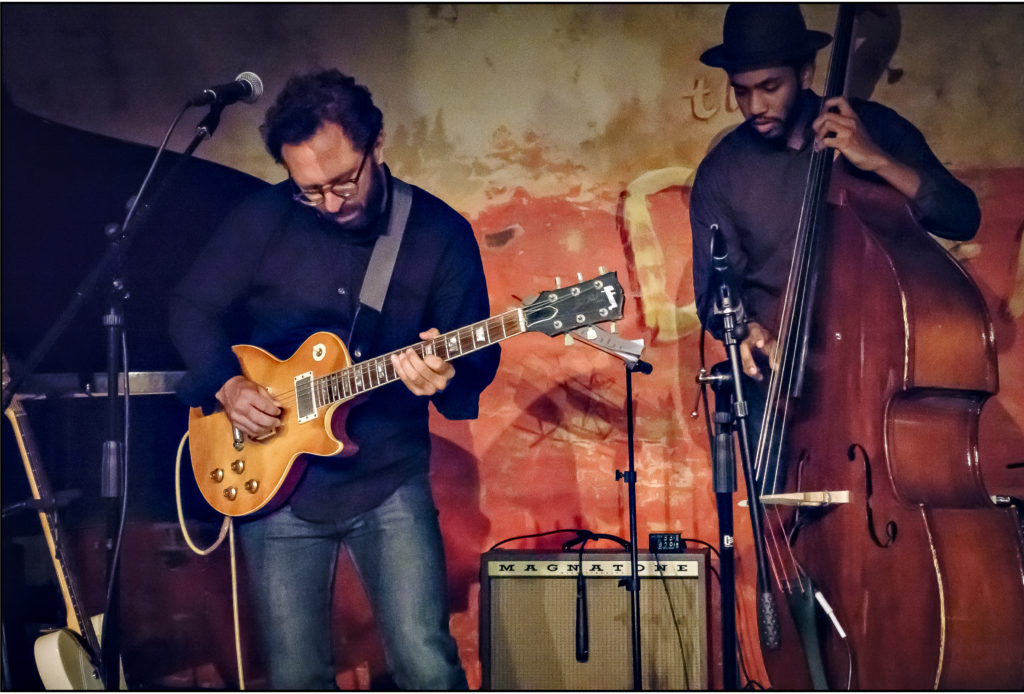
Photograph by David Fields (www.ioconsults.com)
FJ: Fingertips or nails?
AW: Nails. And that’s also something that I am really interested in. I don’t grow my fingernails long, but I grow them a little bit longer, I’m interested in a little bit of the tone of the flesh. Sometimes when my nails get too long I don’t like the sound. I like it if I can tell that a little flesh is hitting the string, too, somehow. Maybe it dampens the string, or something… it’s slightly softer than when I just use nails. I tend to notice it more if I’m playing acoustic guitar. If I’m playing electric guitar I don’t feel like I notice it as much because there’s a lot of other things affecting the tone that’s coming out of the amp. On acoustic I’m trying for something that has a sense of percussion but also has a nice softness, something that feels melodic to me.
One time I sat with Pat Metheny and he showed me his whole nail kit. I was like, man, this is really quite an investment… not just the kit but this is an investment in time and thought about what you want that stuff to be! It sounds fantastic for folks who really go deep into that area, [but] I’ve never had the motivation to go there, even when I’ve taken some time to practice some classical pieces.
Of course, I’m really interested in samba music, Brazilian music, bossa nova, choro. I’m by no means a dedicated student of all that stuff, but I love the sound and I feel like, for me as a player, I gather influence from a lot of things that I like, but I tend to not ever make that next leap, to do what it would take to achieve the thing. My friends who play seven-string violão in Brazil, they’re very serious about their nails. There’s a great documentary film about the choro scene in Rio [The Sound of Rio: Brasileirinho]; it’s about the young choro musicians, and it features Yamandú Costa – he’s one of the most frightening and amazing guitar players on the Earth – he’s really that great, he plays seven-string, choro and samba, very traditional, very technically… it’s insane, it’ll blow your mind – and there’s this great sequence with him at the place that he goes to to get his manicures; he goes to this woman in Rio that sets him up. It’s very important, to get the sound of that music you have to do those things, but whenever I’ve tried to learn from those styles it’s more to gather influence, to gather inspiration and then see how, in my way, I can include it in what feels like a natural way of playing. I’ve always felt that the longer my nails get, it feels less natural.
So, old dog, new tricks. I’ve been playing the way that I play for a long time. I’m not looking to reinvent, but to get, some influence. So, that’s a long way of saying, “Nothing special with the nails.”
FJ: It seems there are two ways of being authentic in those things: there’s being authentic to the style and being authentic to yourself, and sometimes being authentic to yourself is more important.
AW: That’s right. I think there’s the style, and there’s the specifics of the style, or the discipline, the skills and the skill set, and there are intangibles having to do with feel. To me, whenever I can get close to those things that have to do with feel, I feel like my own playing is best-served. If there’s something in a record I really like or a song I really like, as a composer, too, there’s both the transcribing and finding out exactly what the thing is, and then there’s the taking from it and gathering, seeing if you can get close to the feeling that thing creates, which to me is usually the main thing, because that’s usually the thing that attracts me to it.
When I started learning Wes [Montgomery] solos… This was before we had any kind of footage where we could see what he was doing and nobody could tell you; in 1983 nobody could just turn on YouTube and see how Wes was playing with his thumb. People would talk about it, but I don’t recall anyone ever describing what I’ve seen on the videos of Wes Montgomery, in terms of purely technical. So I tried to play with my thumb, because I wanted to see, well, what’s there in the sound and the feel and the sense of forward momentum and swing that he has, and so many things about the way that he plays that are astounding…
FJ: Man, I don’t get it. It makes no sense to me! He’s got his fingers hooked under the body…
AW: I know! It doesn’t! And at the same time, I could say the same thing about Pat Metheny, because when I look at that guy, and the way he holds that pick, none of it makes any… it doesn’t make sense. On paper, I can’t see how it’s achievable, what he does as a guitar player, with that technique. It’s one of those things where, as a student, you just go, “OK…” Really, this whole thing is an open field, and you watch, observe, and find out what these intangibles are that the person possesses, because if I try to hold my pick like Pat, and try to play anything… Ha! First of all, the pick’s gonna fall out of my hand! Right? There are certain people that I watch that I can make sense of, but these things are so personal. I talked with Ted Greene a lot about that, and he would just say, things evolve from the person you are and create the feel that you have, but they don’t create it in a vacuum; it’s all together.
So, I tried a long time to play with my thumb and thought, “Well, this is still not working, it’s not getting me any closer. In fact, when I play along with Wes, I sound closer when I play with a pick, because it feels more congruent to me being able to have better access to the guitar.” It changes when you’re playing chords and octaves, because that really, somehow the thumb determines so much of how the octaves and the chords sound. So if you’re playing one of those solos, I never really did like the sound of the octaves and the chords unless I was playing with my thumb. And now, if I play octaves, a lot of times I put the pick down, or put it in my mouth [laughs]. I tend to put it in my mouth – then I’ll play a passage of octaves with my thumb. Or, if I play an octave on a slower song where I know I’m not going to use the pick, the pick just sits down next to me and I play the whole song with my thumb and fingers. I try different things; the main thing is to know that these are little personal choices and the main thing we’re trying to get close to is that deep part that’s in the feeling of all of it. That’s what I love about it. That’s why you can play something, you can have the notes together and you can really have the timing that you learned, that you really spent a great deal of time transcribing or copying, and it still comes out in some personal way. Because, of course, things that are important to me about learning somebody’s solo… we could have five guitar players sit and learn a Wes Montgomery or a Jim Hall or a Grant Green solo and each person’s gonna play that differently. That’s because of so many different factors. To me, that’s the amazing part of it – it’s important for us all to get close to that inspiration. That’s really the important thing.
BONUS:
Check out Anthony’s performance of the “Spring” movement of his Seasons: A Song Cycle for Guitar Quartet live at the Fretboard Journal with Julian Lage, Chico Pinheiro and Larry Koonse.
